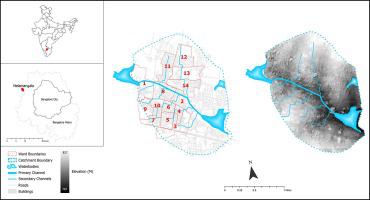Landscape and Urban Planning ( IF 9.1 ) Pub Date : 2022-05-19 , DOI: 10.1016/j.landurbplan.2022.104448 Daniel Phillips , Priyanka Jamwal , Mark Lindquist , Andrew Gronewold

|
Provisional Green Infrastructure (PGI) refers to a range of instream intervention strategies that are currently being developed and deployed by non-state actors in the context of Indian megacities to supplement inefficient operation of grey infrastructures while providing localized multi-functional benefits. This study addresses how variations in the location and configuration of PGI interventions at the watershed catchment scale impact their cumulative performance in terms of contaminant removal efficiency, cost, and public accessibility using a SWMM-based TOPSIS approach. We consider 4 PGI upscaling scenarios in a 5.4 sq. km. watershed in the periphery of Bangalore, India: S1) Downgradient dispersed S2) Downgradient centralized S3) Upgradient dispersed S4) Upgradient centralized. Additionally, S0 was employed as a ‘control’ scenario (in which no interventions are made), and S5 assumed the construction of a conventional wastewater treatment plant (WWTP). Total Suspended Solids (TSS) removal efficiencies ranged from 53% to 97% and performed better in upgradient locations. Total Phosphorus (TP) removal ranged from 59% to 90% and were less sensitive to catchment location, but were substantially improved in scenarios with dispersed configurations. Costs associated with PGI upscaling (4.2–6.3 million INR) were substantially lower than for S5 (37.5 million INR), and accessibility scores were considerably larger in upgradient PGI scenarios. Results suggest dispersed configurations of PGI interventions are optimal wherever such an approach is feasible. In cases where dispersed configurations prove unfeasible, centralized configurations should be placed preferentially in upgradient locations in the watershed, and in locations with higher pollutant concentrations and lower flow rates such as channels with shallower slopes. Authors emphasize PGI should not be viewed as a functional replacement for conventional wastewater treatment infrastructures, but rather as a supplementary stop-gap function in contexts where functional separation of wastewater and stormwater are unlikely to occur, or where existing large scale WWTP’s operate below their designed capacity.
中文翻译:

评估流域内针对干旱天气流量的临时绿色基础设施干预措施的流域规模绩效
临时绿色基础设施 (PGI) 是指目前由非国家行为者在印度特大城市背景下开发和部署的一系列内流干预策略,以补充灰色基础设施的低效运营,同时提供本地化的多功能效益。本研究使用基于 SWMM 的 TOPSIS 方法探讨了流域集水区规模 PGI 干预措施的位置和配置的变化如何影响其在污染物去除效率、成本和公众可及性方面的累积性能。我们在 5.4 平方公里内考虑 4 个 PGI 升级场景。印度班加罗尔外围的分水岭:S1) 下坡分散 S2) 下坡集中 S3) 上坡分散 S4) 上坡集中。此外,S0 被用作“控制”情景(不进行干预),S5 假设建设了一个传统的污水处理厂(WWTP)。总悬浮固体 (TSS) 去除效率在 53% 到 97% 之间,在升级地点表现更好。总磷 (TP) 去除率从 59% 到 90% 不等,对集水区位置不太敏感,但在分散配置的情况下得到了显着改善。与 PGI 升级相关的成本(4.2-630 万印度卢比)大大低于 S5(3750 万印度卢比),并且在升级 PGI 情景中可访问性得分要高得多。结果表明,只要这种方法可行,PGI 干预的分散配置是最佳的。在分散配置证明不可行的情况下,集中配置应优先布置在流域内的上坡位置,以及坡度较浅的河道等污染物浓度较高、流速较低的位置。作者强调 PGI 不应被视为传统废水处理基础设施的功能替代品,而应被视为一种在废水和雨水的功能分离不太可能发生的情况下,或现有的大型污水处理厂的运行低于其设计容量的情况下,补充权宜之计功能。


























 京公网安备 11010802027423号
京公网安备 11010802027423号